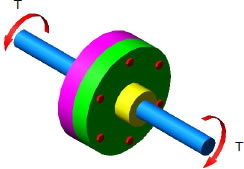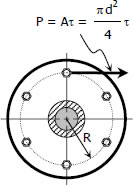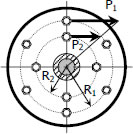Flanged bolt couplings
In shaft connection called flanged bolt couplings (see figure), the torque is transmitted by the shearing force P created in he bolts that is assumed to be uniformly distributed. For any number of bolts n, the torque capacity of the coupling is


 If a coupling has two concentric rows of bolts, the torque capacity is
If a coupling has two concentric rows of bolts, the torque capacity is
where the subscript 1 refer to bolts on the outer circle an subscript 2 refer to bolts on the inner circle. See figure.
For rigid flanges, the shear deformations in the bolts are proportional to their radial distances from the shaft axis. The shearing strains are related by
Using Hooke's law for shear, G = τ / γ, we have
If the bolts on the two circles have the same area, A1 = A2, and if the bolts are made of the same material, G1 = G2, the relation between P1 and P2 reduces to
- Log in to post comments
